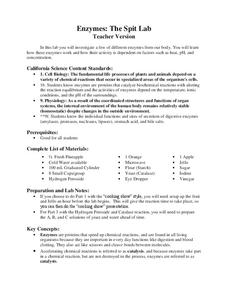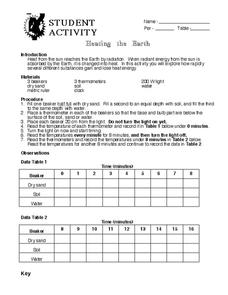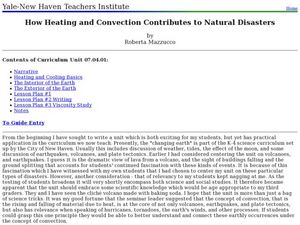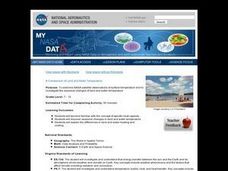It's About Time
What Drives the Plates?
It's getting hot in here! Lead your emerging geoscientists on a thrilling journey as they calculate liquid densities to determine forces that stimulate thermal plates from within the earth's crust. They explore effects of temperature on...
Colorado State University
If Hot Air Rises, Why Is it Cold in the Mountains?
Investigate the relationship between temperature and pressure. Learners change the pressure of a sample of air and monitor its temperature. They learn that as air decreases its pressure, its thermal energy converts to kinetic energy.
Science Matters
Peanut Energy
How do humans get energy since they aren't mechanical and can't photosynthesize? Learners explore this question by relating potential energy in food to human energy levels. Scholars measure the change in mass and a change in temperature...
Discovery Education
It's Melting!
It's a race to the finish! Which ice cube will melt the fastest? Scholars discover the effect thermal energy has on melting ice. They experiment with melting ice cubes on different materials and learn that even at a consistent...
NASA
States of Matter
Water, one of the basic needs of humans, is found in all three states of matter on Earth; no other planet—that we know of—possesses this quality. Here is a unit that allows learners to explore through experimentation what it takes to...
NOAA
The Oceanographic Yo-yo
How does chemistry help deep-sea explorers? Part four of a five-part series of lessons from aboard the Okeanos Explorer introduces middle school scientists to technologies used in ocean exploration. Groups work together to analyze data...
LABScI
Enzymes: The Spit Lab
Enzymes in our bodies each have a job to do. Learn the factors that affect the activity of some enzymes using the third activity of an informative 12-part biology series. A three-part laboratory activity asks teams to investigate how...
Colorado State University
Can Gravity Push Something Up?
How does a hot air balloon fly? An experimental lesson has scholars build a balloon from a garbage bag and monitor the movement of air. As the temperature of the air in the balloon increases, gravity moves the denser cool air down,...
Curated OER
Heating The Atmosphere
In this science worksheet, students look for the answers to finding the correct temperatures that match the location in the atmosphere.
Curated OER
Heat Transfer & Phase Changes
In this heat transfer and phase change worksheet, students experiment with ice, salt, and milk to show the relationship between the temperature of a solution and its phase. Students turn milk from a liquid to a solid and graph the...
Curated OER
Heating/Cooling Curve
For this heating and cooling curve worksheet, students use a given graph of a substance being heated from a solid to a liquid and then a gas over time. They use the graph to answer eleven questions about the phases of the substance and...
Curated OER
Heat Index
In this algebra activity, students solve for the heat index using the correct variable. There is an answer key with this activity.
Curated OER
Passing The Heat Along
Fifth graders consider conduction. In this science lesson plan, 5th graders explore how heat passes through conductors and examine materials that contain heat.
Curated OER
How Heating and Convection Contributes to Natural Disasters
Students study the basics of heating and cooling and how it pertains to the earth. In this global lesson students read the Magic Tree House book then create a chart of their findings.
Curated OER
The Affect of Water Temperature on Living Organisms
Students examine the environmental impact of global warming. In this environmental science lesson, students design and conduct an experiment about the effect of temperature on paramecia. They write a lab report about their experiment.
Curated OER
Solar Energy Lab
In this solar energy instructional activity, students experiment with soil and water to determine if they heat at different rates. They record the temperature of the soil and water under light and in the dark. They graph their data and...
Curated OER
Heat Absorption
Students examine how heat moves from substance to another. In this heat absorption instructional activity students identify ways that heat is transferred and analyze data.
Curated OER
If You Can’t Stand the Heat
Students design and build their own solar cooker. In this math lesson, students determine the relationship between the angles of the sun, reflection and cooking time of the solar cooker. They test their project, collect data and analyze...
Curated OER
A Comparison of Land and Water Temperature
Students use the NASA website's Live Access Server to create a graph of surface temperature at two locations on earth. They analyze the data and then answer specific questions provided in this lesson. They also examine and compare the...
Curated OER
Specific Heat and Insulation - Temperature Changes
Learners expand their knowledge of how temperature changes between air and soil. They also examine how natural grass cover insulates the effects of the sun's direct radiation.
Curated OER
Taking In The Heat
Pupils discover that different textured materials can absorb more heat than others. Students work with thermometers, clocks, and graphs.
Curated OER
Sunlight and Heat
Learners brainstorm about the sources of heat. They discuss that sunlight is one of those sources. Students complete a lab about cold water and warm water. They record the temperatures from each thermometer and discuss which container...
Curated OER
Heat from Machines
Third graders continue their examination of the heat energy from machines. In groups, they make predictions on which machines might produce a measureable amount of heat. They take the temperatures of the various machines and record them...
Curated OER
Computer Science: Temperature
Students conduct an experiment on heat transfer and how it works. They record the temperature in whatever environment is surrounding the container and run experiments that use at least two different ambient temperatures. Students...
Other popular searches
- Physics Heat and Temperature
- Science Heat and Temperature
- Heat and Temperature Test
- Temperature and Heat
- Heat and Temperature Change
- Heat and Temperature Metal
- Heat Energy Temperature Burn
- Temperature Heat Expansion
- Temperature Scales and Heat
- Heat and Temperature Unit
- Temperature Heat
- Temperature Flow of Heat

























